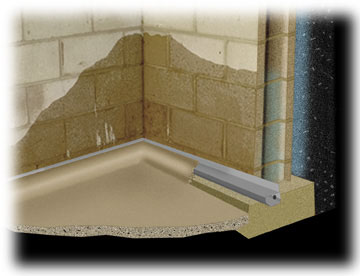Wary fixes to be cautious of
Why your basement leaks
Preventive tips
Dry basement quiz
DownSpout Extentions
Contractor installed systems
How to choose the right system
Systems for new construction
Sump pumps
Drain tile systems
Fixes to be wary of
Do-it-yourself systems
Baseboard systems
Musty basement smell
Finishing tips for your basement
What to do after the flood

When choosing your basement waterproofing system, go the extra distance and compare several different types of remedies. For sub-floor systems there are several remedies to consider. We recommend drain tile along the inside footings in a bed of pea rock. The top of the tile should be set deep enough so the top of the tile is level with the top of the footings. Holes should be tapped in the bottom row of blocks to drain the walls into a low profile basement waterproofing system. This allows you to pour the floor using several inches of concrete.
Drain tile or any other high profile system should never be installed on top of the footing. We do not recommend any system that requires the floor to be poured at an angle up the wall as pictured above.
Avoid any digging around the outside of your foundation. This disturbs the vital compaction incurred over years of settlement and generates a sponge like condition.
Waterproofing paints and plug-its are rarely used by the professional waterproofers... For good reason. Over time, the lime in the cement promotes growth of mildew between the walls and the paint. Huge boils and blisters form and then paint begins to shale. The professionals install some type of drainage system.
Submit your HandyMan tip here: Click here.
View tips sent to our HandyMan: Click here.
